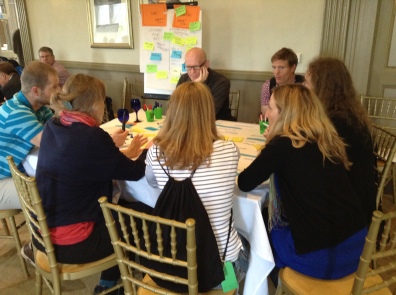In the UK there seems to be consensus on just one issue, uncertainty has increased since the UK Brexit vote on 23rd June. In our organisations, one key question is how to manage uncertainty and lead our organisations through the coming months and years?

As the floods have taught us, nothing is predictable and stable!
Today’s UK situation reminds me of a business situation I experienced several years ago. During this period of uncertainty we ran a series of workshops using the ‘exploratory approach’ to Scenario Planning. This workshops had a big impact on our business and helped us to move forward through the ‘fog’ with some confidence – we managed uncertainty.
The situation then, in early 1990’s, was that the company I worked for faced a high degree of technical uncertainty. The company was very successful in fixed cabled voice telephones. All around the world was changing rapidly. Desktop computing, mobile computing, mobile telephony, high speed data, wireless technology were all perceived as an opportunity, or threat, to the company’s traditional technology and product base.
Using Scenario Planning
I was part of the management team that addressed this, assisted by external facilitators, using the exploratory approach to scenario planning. People with differing perspectives worked together in workshops to describe 4 alternative, but possible futures. The possibilities were that the future of communication would be dominated by
- Low Cost
- High data rate demand;
- Maximum mobility;
- Maximum security (of information)
The objective was not to predict what the future would be, (that was too uncertain), rather to create a series of plausible futures. This approach had the advantage that different perspectives were automatically valued and listened to and captured. (Interestingly, 30 years on, we could debate how things have evolved. In practice, I believe that it is a hybrid of the possible scenario worlds we described at that time).

Once we had defined the 4 plausible futures or ‘scenarios’ we looked at each in turn and addressed what actions (e.g. technology development, product development, skills development), we could take to prepare ourselves to prosper in that world. When that was completed for all 4 plausible futures, we found that some actions were appropriate for all 4 of the different scenarios; whilst some actions were unique to a single scenario.

The important point is that the work we did on the scenarios enabled the marketing, technology and new product development teams to prioritise and focus on actions which would be very relevant, useful and revenue generating in 2 or 3 of the scenarios.
Decisions were made and we emerged from the process with a clear agreed plan of strategic and tactical actions – we were managing in uncertainty!
Nigel Chapman, Director, Centre for Facilitation
To discuss ideas for future strategy planning events contact us via our website

You must be logged in to post a comment.